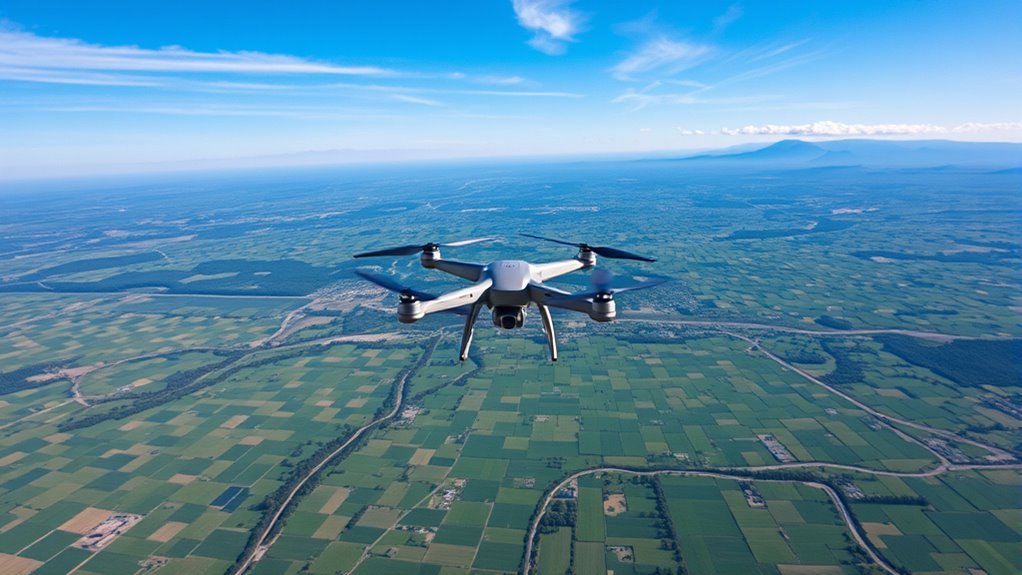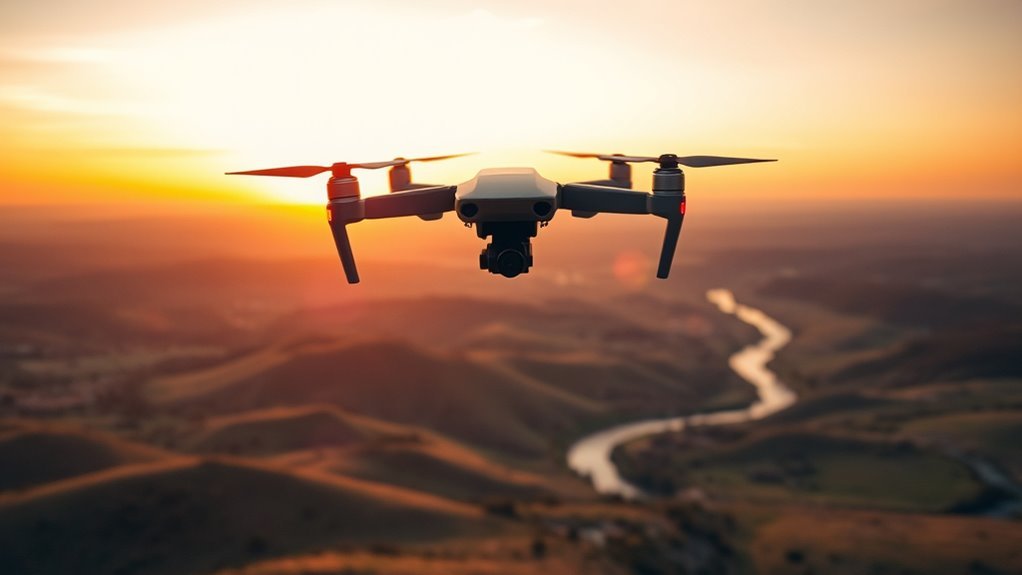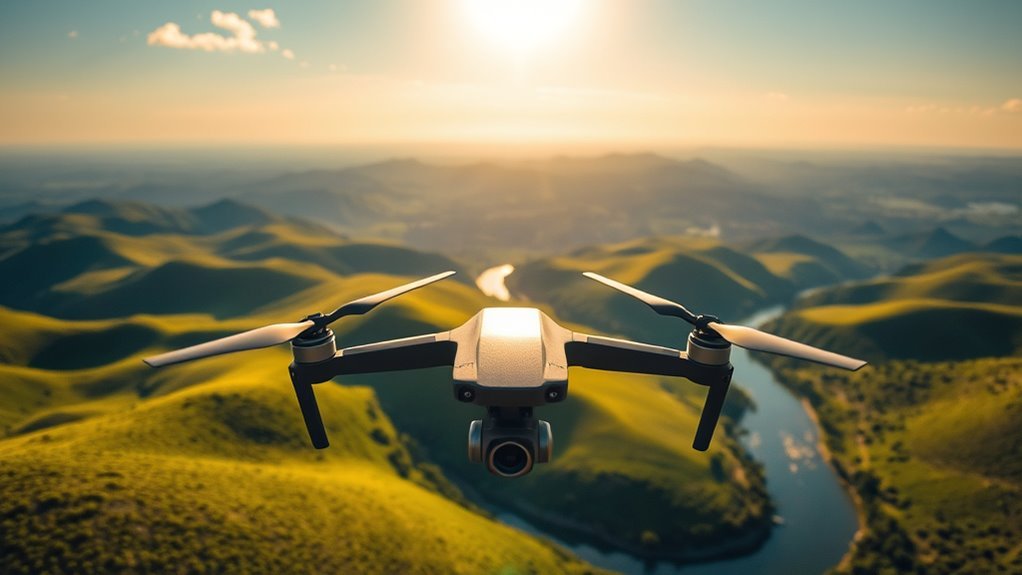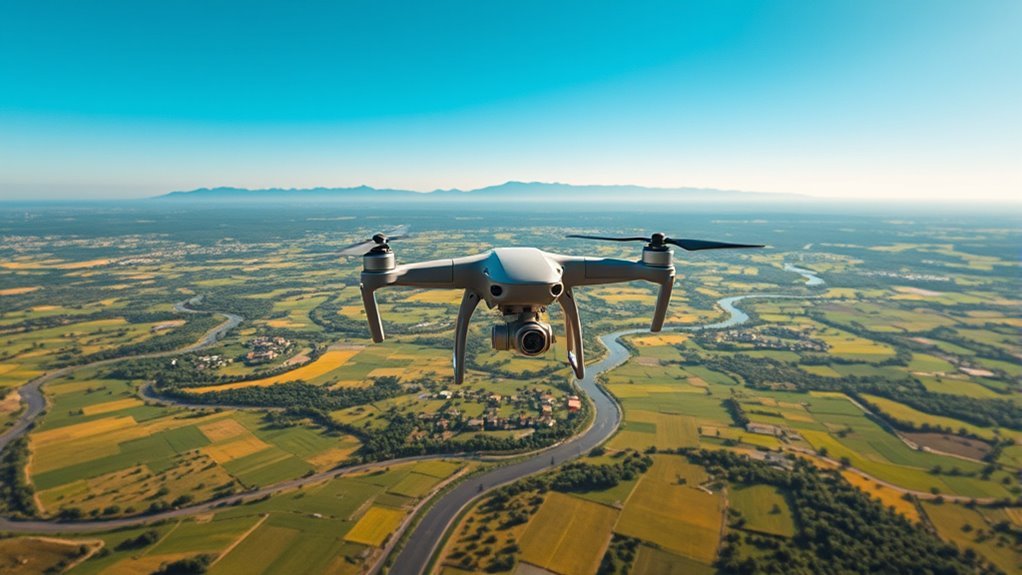The distance you can fly your drone depends on several factors. Battery life, environmental conditions, and legal regulations all play an essential role. Signal interference from obstacles, like buildings or trees, can limit control range. Additionally, airspace restrictions may prevent you from flying near airports or national parks. To maximize your drone’s distance and guarantee compliance, it’s important to understand these limitations thoroughly. There’s much more you can learn about optimizing your drone’s flight experience.
Understanding Drone Range Limitations

Understanding the range limitations of your drone is essential, especially since these constraints can greatly impact your flight plans. Drone technology varies considerably, with factors such as battery life, environmental conditions, and signal interference affecting your range. You need to account for potential obstacles like buildings and trees that can disrupt the signal, leading to reduced control over your device. Additionally, the frequency bands and channels used by your drone can influence its operational distance. As you explore new locations, be aware of how these elements could restrict your freedom to maneuver. By thoroughly understanding these limitations, you can optimize your flight experience, ensuring you make the most of your drone’s capabilities while minimizing risks associated with range issues. Moreover, understanding the battery capacity of your drone is crucial, as it directly influences the flight duration and operational range. The controller frequency bands used by your drone play a significant role in determining how far you can fly from your location.
Legal Regulations Governing Drone Flight Distance

While grasping the technical aspects of drone range is important, compliance with legal regulations surrounding flight distance is equally vital. You need to be aware of the drone registration requirements mandated by aviation authorities. Failing to register your drone can limit your operational range and expose you to legal penalties. Additionally, airspace restrictions play a significant role in determining how far you can fly. Certain areas, such as near airports or national parks, may have strict limitations that could impede your freedom to explore. Always check the local regulations and guarantee you’re informed about no-fly zones. By understanding these legal frameworks, you can enjoy your flights while respecting the necessary boundaries set for safety and compliance. Furthermore, ensure you obtain appropriate permits to fly in specific areas, such as national forests, to avoid potential fines and penalties. It’s also essential to respect property rights when flying over residential areas, as this can affect the legality of your flight.
Factors Affecting Drone Flight Range

Several factors greatly influence how far you can fly your drone. Understanding these elements is essential for maximizing your aerial adventures:
- Battery Capacity: Higher capacity allows for longer flight times. Additionally, higher battery capacity can provide greater operational freedom when planning long flights.
- Environmental Factors: Wind, temperature, and humidity can impact range.
- Signal Interference: Obstacles like buildings or trees can obstruct communication.
- Drone Weight: Heavier drones consume more power, reducing range.
- Flight Mode: Different modes (e.g., sport vs. GPS) affect energy efficiency.
Additionally, the battery life of your drone significantly affects how far you can travel before needing to return for a recharge.
Tips for Maximizing Your Drone’s Distance
To maximize your drone’s distance, it is crucial to implement strategic practices that enhance efficiency and performance. Start by optimizing your drone battery usage; a fully charged battery can notably extend your flight range. Additionally, monitor your signal strength, as strong signals guarantee uninterrupted communication with your drone, allowing for longer distances. Understanding battery capacity is essential for selecting the right battery to achieve optimal flight times. Here’s a quick reference table to guide you:
| Practice | Impact on Distance | Notes |
|---|---|---|
| Optimize Battery Usage | High | Avoid rapid maneuvers |
| Maintain Signal Strength | High | Avoid obstacles |
| Fly at Moderate Altitude | Medium | Reduces wind resistance |
| Use the Right Antenna | High | Enhances signal reception |
| Limit Payload Weight | Medium | Increases overall efficiency |
Implementing efficient power management systems can also help in maintaining optimal performance for an extended flying experience.
Best Practices for Safe and Responsible Drone Operation
Guaranteeing safe and responsible drone operation is essential not only for the longevity of your equipment but also for maintaining public safety and compliance with regulations. To achieve this, consider the following best practices:
- Conduct regular drone maintenance to guarantee peak performance.
- Familiarize yourself with local regulations and airspace restrictions, as these can vary widely by location.
- Always maintain visual line-of-sight with your drone during flight.
- Develop and rehearse emergency procedures in case of equipment failure.
- Respect privacy and avoid flying over crowded areas.
- Understanding the signal stability of your drone’s transmission technology can enhance performance in complex environments.
Frequently Asked Questions
Can I Fly My Drone Over Water Bodies?
You can fly your drone over water bodies, but you must comply with drone regulations. Always prioritize water safety; verify your drone’s battery is sufficient and maintain visual line of sight for ideal control.
What Happens if I Lose Signal With My Drone?
When your drone suddenly becomes a ship lost at sea due to signal loss, you’ve got recovery options. It’ll either return to home automatically or hover until you regain control—freedom’s fine line between control and chaos.
Are There Any Apps to Monitor Drone Distance?
Yes, there are several apps for drone tracking that monitor distance and flight limits. These tools help you stay within regulations while ensuring you can explore your surroundings without exceeding safe operational boundaries.
How Can I Improve My Drone’s Battery Life?
To improve your drone’s battery life, focus on battery maintenance and weight reduction. Regularly check connections, avoid deep discharges, and eliminate unnecessary components to enhance efficiency, giving you more freedom in the sky.
Is It Safe to Fly Drones During Windy Conditions?
Is it really wise to fly your drone in windy conditions? Wind resistance can severely impact stability. Always prioritize safety precautions to guarantee a smooth flight, avoiding gusty weather for maximum performance and control over your drone.

